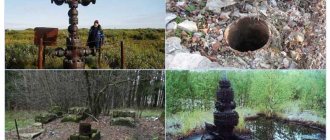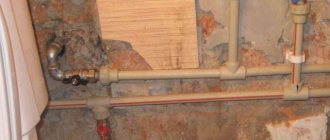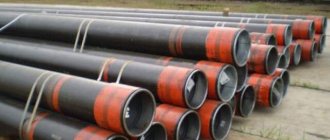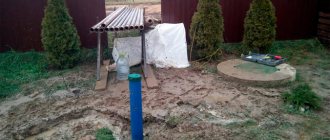Abandonment of wells is simply necessary. Liquidation plugging of wells is carried out in order to eliminate the possibility of contamination of exploited aquifers from the surface of the earth and to prevent mixing of waters of different horizons having different chemical compositions. Wellbore plugging protects the water horizon from penetration of surface water or water from another horizon, and prevents the possibility of chemical or bacteriological contamination of the horizon.
Which wells are subject to abandonment?
There are many factors that determine the need for liquidation plugging - abandonment of a well.
Abandoned wells are divided into 4 categories:
- Exploration wells drilled to determine the characteristics of the aquifer, experimental pumping.
- Artesian wells with expired service life are wells, the further operation of which is difficult due to severe corrosion of the casing pipes, a drop in flow rate, etc.
- The wells are in disrepair and cannot be repaired.
- Wells in need of abandonment, which cannot be operated for technological and environmental reasons, end up in the development zone, unable to withstand the SSO regime. Wells whose owners violate the terms of the license also fall into this category.
Reasons for abandoning wells
The poor condition of the internal equipment of the mine leads to significant contamination of the source. As a rule, its average service life without replacing equipment is 25 years, after which the intensive development of corrosion processes begins. Therefore, mines whose service life has expired are subject to either restoration or liquidation. In this case, major repairs include replacing casing columns, cleaning the channel, and conducting new studies of the source’s performance. The costs for it amount to up to 70% of the cost of constructing a new mine, so in many cases the cost of well plugging is much lower than the total restoration costs.
Grounds for liquidation:
- unjustified economic indicators of water extraction;
- inappropriateness of capital restoration of the facility (especially if it is not in use);
- structural defects and low flow rate;
- identification of environmental pollution threats;
- destruction of the casing pipe structure.
There is also often a need to plug test wells.
Categories of liquidated objects
Well abandonment work is carried out in 4 types of workings:
- Exploration wells and pilot pumping wells drilled to determine the properties of the aquifer.
- Artesian wells with expired service life.
- Wells that are in disrepair and cannot be restored.
- Facilities whose operation is impractical for economic or technological reasons.
The latter category also includes wells whose owners violated licensing conditions.
Technologies used for well abandonment
Currently, well abandonment work is most often carried out using two technologies. And in particular:
1. it is possible to plug the space behind the casing in cases where it is necessary to protect the source and wellbore from the penetration of perched water and groundwater;
2. liquidation plugging of wells is used, which involves cementing the trunk of the water intake structure. This technology is used in situations where an old hydraulic structure poses a danger, for example, it can cause contamination of underground aquifers.
Work on the abandonment of wells begins with the collection of analyzes and examinations. Based on these data, a decision is made about which technology for performing the procedure is optimal.
Our company’s specialists have significant experience in the field of liquidation of water intake structures. They are ready to provide professional advice and answer questions regarding the liquidation technologies used.
Cost of the project and work to abandon wells
Before the liquidation of a water well , a project must be drawn up.
Drawing up a project for liquidation plugging is estimated at 70,000 rubles.
The cost of work during which the well is abandoned depends on the scope of work for cleaning the wellbore, a set of geophysical studies, the depth of the well and the diameter of its production casing. Approximately, the cost of liquidation plugging of a well ranges from 1,400 to 1,800 rubles per 1 meter of well.
Design cost
| Service | Price, thousand rubles |
| Liquidation plugging project | from 50 |
order service
Backfilling is a set of measures to abandon a well and restore the geological environment, aimed at protecting the aquifer from suspected chemical and biological contamination. It involves cementing, completely shutting off and isolating the aquifer through a cement bridge. The entire cavity, which is located between the casing and the wellbore, is cemented, which depends on the geological section. Instead of conventional cement plugging, liquid plastics and especially thick clay compositions can be used. Liquidation plugging can be performed quite quickly.
Stages of work during well abandonment:
- Preparing the site for the drilling rig;
- Installation and dismantling of the drilling unit;
- Circulation system design;
- Geophysical survey of the well;
- Experimental pumping of water from a well;
- Preparation of clay solution;
- Removing foreign objects from the well;
- Drilling out a sand plug;
- Flushing the well with water;
- Well disinfection;
- Sand or gravel backfill of the filter part of the well;
- Injection of cement-clay solution;
- Digging a pit;
- Trimming casing pipes and welding plugs;
- Filling the bottom of the pit;
- Backfilling of the pit.
At the site of the mouth of the former well, after the abandonment of the well, a flat platform is built that can be used for economic purposes.
It is important for the customer to know about well abandonment
The abandonment of wells must be carried out in accordance with the design documentation within the time limits agreed upon with the territorial bodies of the Gosgortekhnadzor of Russia.
The abandonment of wells is considered completed after the subsoil user signs the act of abandonment.
Elimination of water wells in the Moscow region
According to experts, in the Moscow region alone there are several thousand abandoned wells of various types and purposes: former operational wells, as well as exploration, regime, drainage, parametric, geotechnical; There are also abandoned wells on the territories of military units, both active and disbanded, that need to be eliminated.
Order well abandonment work from our managers by phone.
Reasons for developing a well plugging project
The cost of a well plugging project depends on the bottomhole depth and the diameter of the production string. During the work, the site is prepared for geophysical survey and drilling rig. Casing pipes have a certain service life. Due to corrosion over time, they become a source of pollution that affects water quality.
You can check prices for services by calling Moscow 8 (495) 540-49-31.
- strictly according to a pre-developed well plugging project using specific technological solutions;
- using special equipment for which there are certificates of conformity.
INSTRUCTIONS ON THE PROCEDURE FOR LIQUIDATION, PRESERVATION OF WELLS AND EQUIPMENT FOR THEIR MOUTHES AND SHARES (RD 08-492-02)
Construction of the caisson
Regulations
For proper installation of a water supply system, the best option is to install a caisson. Its presence allows you to increase the depth of the well to the level of soil freezing.
Caissons can be made in different shapes, although round ones are considered the best option for wells. Such devices are produced both from metal and from polymer material and even concrete. But the standard is polypropylene; products made from it are distinguished by their low weight and long service life. Such material is cheaper than metal, and such caissons are in consistently high demand.
What objects need to be preserved?
In order for a decision to be made to suspend operation, certain indicators must be present:
- production has lost the ability to perform the tasks assigned to it;
- if it was of an exploratory nature;
- was created on the basis of erroneous geological soil analyses;
- construction was carried out with some violations;
- emergency position of the object;
- The facility was built in a protected area.
Conservation of oil wells is carried out only after the creation of a special project, which includes design and estimate documentation.
Good reasons
There should be no “orphan” wells in domestic latitudes. They must either be used or preserved. Sometimes refusal to use a source is a forced measure, which owners will have to take into account. Otherwise, they will face a fine and forced work.
The following types of wells are subject to temporary conservation:
- Permanent, the use of which will not be necessary for several years;
- Intelligence, which have already fulfilled their function, but are to be used as permanent ones in the future;
- Blowing out due to in-situ pressure, until the situation normalizes.
In this case, the sources are not completely plugged, so they can be reopened at any time. However, this type of work must be performed by a professional.
Meanwhile, there are also categories of water intake sources that are subject to complete elimination:
- Emergency situations that pose a danger to humans and the environment;
- Exhausted water resources;
- Drilled in violation of existing standards;
- Reconnaissance, not intended for further exploitation;
- Temporary type.
According to current legislation, all financial costs are borne by the owner. If one is not found, the state has to pay for the liquidation.
Conservation, reasons for its implementation
To preserve the trunk, the well is preserved during a long break in operation by sealing its mouth. The preservation period can be very different - from a couple of months to a year or more. This figure may differ depending on why the well must be suspended. Conservation is carried out both during construction and during the operation of the well.
The well quickly fails if you stop using it. To continue its operation after a long break may require expensive repairs. To prevent such problems, the well is mothballed.
There are other reasons for mothballing a well. Among them:
- Stopping drilling due to accidents and force majeure;
- Out of money;
- Inconsistency between technical capabilities and design parameters;
- Blockage of a self-flowing source.
A distinction is made between long-term preservation, which is carried out through the construction of a cement bridge, and for the winter period (seasonal preservation). It is also worth noting that during conservation lasting more than one year, all technical equipment - pumps, pipes, filters, automation, various sensors - are removed.
Conservation of an artesian well
Conservation of an artesian well is a temporary measure that is carried out if an autonomous source of water supply is not in use for some time. For example, artesian wells are often preserved for the winter.
If conservation is carried out in an area with a harsh climate, then increased attention must be paid to the issues of its insulation. For this purpose, modern thermal insulation materials are used. The work should be trusted only to competent professionals.
FIND OUT THE COST OF WORK
If the work is carried out in a milder climate, then natural materials, such as straw or peat, can be used as insulation. They do a great job with these functions (if done correctly).
You can preserve an autonomous source of water supply for a short time by simply placing a heater inside the casing. There are more expensive heater models equipped with sensors that respond to water temperature.
Types of liquidation
Well plugging is divided into several methods. When choosing, the reason for liquidation and the type of soil are taken into account. Cement plugging is used in clay soils. The porous layers of the earth are filled with mixed compounds.
The procedure is performed using direct, reverse or multi-level technology. Direct grouting involves filling the voids between the casing and the ground with a special solution. The composition sinks to a depth and takes the required shape. It is impossible to control the entire process.
Back plugging of wells involves pouring an insulating compound into the casing. After immersion, the solution is removed from the structure and fills the space between the wall and the ground. Multi-level structures are plugged during the drilling process. The water intake is filled at all stages of casing. When eliminating by plugging, the water intake is filled with cement or clay mortar. To operate, you need a pumping device, a drill and cement. The composition fills the void of the pit, supplied under high pressure. A cement plug is formed at the mouth, to which a sign is attached with information: depth and category of water intake.
Conservation and reactivation of wells
— What is the point of mothballing a well?
— In Russia, a fairly large number of wells are operated in the so-called “dissolved gas” mode. Reservoir pressure in such wells has dropped below the saturation point, and they are prime candidates for conservation.
A well conservation project is being preliminarily prepared, which must be approved by the supervisory authority. The conservation process is quite long. It is no coincidence that oil wells burned in Kuwait and Iraq when military conflicts began to arise there in the late 1990s. Fires in hundreds of wells occurred because, due to force majeure, they did not have time to extinguish them.
Typically, the mothballing of production wells is carried out taking into account the possibility of further development. Conservation is used in the following cases: either safety standards are violated and an emergency occurs; or the well becomes unprofitable due to low flow rate. Or because of changes in oil prices.
The procedure for mothballing wells for a period of up to a year is as follows: working equipment is lifted from the well to the surface; the wellbore is washed and cleaned; then they are filled with a heavy solution that counteracts the formation pressure.
During long-term conservation, cement bridges are created in wells above the perforated area above the top of the formation. The rest of the casing (structure for fastening drill wells - N.M.) is filled with oil or diesel fuel. The handwheels are removed from the wellhead valves, plugs are placed on the flanges, and pressure gauges are sealed. The condition of the wells is checked twice a year.
— How will the well be reactivated later?
— Re-opening and commissioning can take several months. The process of re-summoning the flow of oil is especially long. It happens that a well begins to produce oil only after six months.
After reactivation, the well may “forget” that it was in operation. Oil has qualities called “rheological properties.” That is, she has a kind of memory. If production is stopped, oil settles in the pores and putting it into motion subsequently becomes costly: this requires the use of modern technologies.
— How does the technological process for conserving shale deposits in the USA differ from ours?
— The technologies are approximately the same and have been proven for a long time. Another thing is that shale oil is a special type of hydrocarbon. Its extraction is associated with extremely low porosity of the raw material formations, which makes extraction difficult.
To increase returns, Americans use a method called hydraulic fracturing. It involves pumping thousands of tons of special fluid under high pressure. Passages for oil are created. The formation becomes permeable and the “black gold” approaches the well through the cracks formed.
This technology has been actively developed over the past 20-30 years. Its use allowed the Americans to break into first positions among the world's mining countries. The cost of such production is not cheap - $30-40, and sometimes $50 per barrel. At current prices, such raw materials cannot compete with traditional oil. The cost of mining “black gold” in the North Sea or Mexico does not exceed $10-12.
— Some authoritative representatives of the industry refer to the technological features of different mining regions of the world. If in Saudi Arabia it is enough to simply “turn off the valve” to reduce production, then in Russia stopping production could lead to the collapse of the project - and the need for additional work comparable to what was already done when putting the field into commercial operation. Which makes our potential losses much higher. Is this really true?
- Not really. The concept of “close the valve” is very relative. It also requires many technological operations.
Of course, production at low-profit facilities in Russia can be stopped completely or suspended until “better times.” But wells whose productivity is at an acceptable cost level can be technologically varied using a fitting through which raw materials are supplied. By narrowing its hole, it is possible to change the volume of hydrocarbon production.
This technology is widely used throughout the world - not only in Saudi Arabia, but also in Russia. By reducing production, all parties to the transaction will use the maximum permissible methods to reduce production and preserve the resource fund. Everyone is going to reserve the opportunity, on occasion, to quickly increase production if market demand grows.
If we give some general assessment of Russian losses, then as a result of all the ongoing price fluctuations on the oil market, the Russian budget may fall short of up to $30 billion this year.
www.mk.ru/economics/2020/04/14/ostanovit-skvazhiny-opisano-sokrashhenie-dobychi-nefti-v-rossii.html
How to identify a breakdown?
The effectiveness of repair measures and the total cost of restoration work depend on the correct diagnosis of the problem.
A complete lack of water in the water supply system most often indicates a breakdown of the automatic control unit or pump, and low pressure is usually associated with a malfunction of water distribution equipment. To determine the cause, you need to inspect the pipeline joints and make sure they are tight, inspect the hydraulic tank and other elements of the system.
The pit or caisson is inspected first (there should be no water or ice in it), then the condition of the casing pipes is checked. The curvature of the casing is fraught with big troubles. If the problem is not discovered, further diagnostics should be carried out based on the condition of the water coming from the well:
- Water with obvious impurities of silt or sand indicates the destruction of the filter and silting of the production casing shaft.
- The flow of clean water in small quantities indicates that the filter is clogged. It just needs to be cleaned.
Reactivation of sand wells
With the onset of the warm season, wells prepared for winter should be reopened.
According to the conservation rules, all pumping equipment had to be removed from the well, washed and dried, all water drained from the water supply system, and the mouth closed with a waterproof cap. Now it's time to revive your water supply.
In sand wells, during a long break in operation, the filter part of the casing pipe becomes silted. The first step is to clean the well from the “cocoon”, consisting of fine clay deposits that have clogged the water inflow zone. This can be accomplished by hydrotreating, pneumatic treating, or chemically treating the well. Next, the well should be thoroughly pumped.











